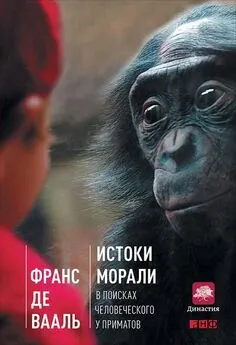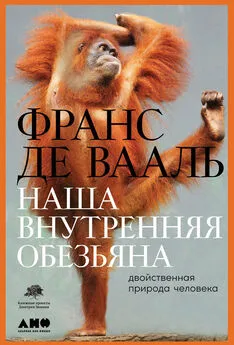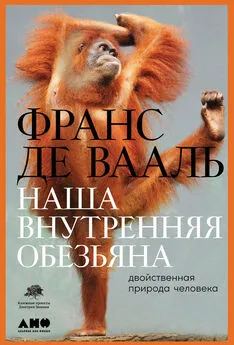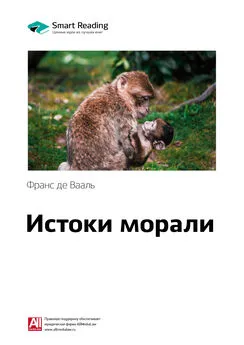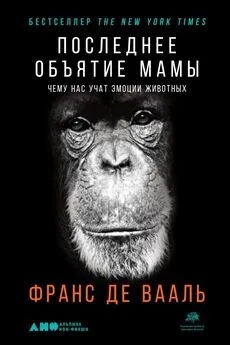Франс Вааль - Последнее объятие Мамы [litres]
- Название:Последнее объятие Мамы [litres]
- Автор:
- Жанр:
- Издательство:Литагент Альпина
- Год:2020
- Город:Москва
- ISBN:978-5-0013-9214-9
- Рейтинг:
- Избранное:Добавить в избранное
-
Отзывы:
-
Ваша оценка:
Франс Вааль - Последнее объятие Мамы [litres] краткое содержание
В этой доброй и умной книге, помимо трогательной истории шимпанзе по имени Мама, известный приматолог Франс де Вааль рассказывает о своих многочисленных наблюдениях и экспериментах, посвященных изучению эмоций самых разных животных. Наряду с гневом и ненавистью, приводящими даже к преднамеренному убийству себе подобных, животные обнаруживают удивительную способность к состраданию, примирению и прощению. Они, как и мы, способны к эмпатии, взаимопомощи и тесному социальному взаимодействию.
Автор рассматривает чувства человека в эволюционном контексте как прямое продолжение эмоций животных и призывает осознать нашу неразрывную связь со всеми существами на планете и в конечном счете лучше понять самих себя.
Последнее объятие Мамы [litres] - читать онлайн бесплатно ознакомительный отрывок
Интервал:
Закладка:
Baumeister, R. F. 2008. Free will in scientific psychology. Perspectives on Psychological Science 3:14–19.
Bekoff, M. 1972. The development of social interaction, play, and metacommunication in mammals: An ethological perspective. Quarterly Review of Biology 47:412–34.
Beran, M. J. 2002. Maintenance of self-imposed delay of gratification by four chimpanzees ( Pan troglodytes ) and an orangutan ( Pongo pygmaeus ). Journal of General Psychology 129:49–66.
Berns, G. S., A. Brooks, and M. Spivak. 2013. Replicability and heterogeneity of awake unrestrained canine fMRI responses. PLoS ONE 8: e81698.
Biro, D., T. Humle, K. Koops, C. Sousa, M. Hayashi, and T. Matsuzawa. 2010. Chimpanzee mothers at Bossou, Guinea, carry the mummified remains of their dead infants. Current Biology 20: R351 – R352.
Bloom, P. 2016. Against Empathy: The Case for Rational Compassion . New York: Ecco.
Boesch, C. 1994. Cooperative hunting in wild chimpanzees. Animal Behaviour 48:653–67.
Bosch, O. J., et al. 2009. The CRF System mediates increased passive stresscoping behavior following the loss of a bonded partner in a monogamous rodent. Neuropsychopharmacology 34:1406–15.
Braithwaite, V. 2010. Do Fish Feel Pain? Oxford: Oxford University Press.
Brosnan, S. F., and F. B. M. de Waal. 2003a. Regulation of vocal output by chimpanzees finding food in the presence or absence of an audience. Evolution of Communication 4:211–24.
–. 2003b. Monkeys reject unequal pay. Nature 425:297–99.
–. 2014. The evolution of responses to (un) fairness. Science 346:314–322.
Brotcorne, F., et al. 2017. Intergroup variation in robbing and bartering by longtailed macaques at Uluwatu Temple (Bali, Indonesia). Primates 58:505–16.
Buchanan, T. W., S. L. Bagley, R. B. Stansfield, and S. D. Preston. 2012. The empathic, physiological resonance of stress. Social Neuroscience 7:191–201.
Burkett, J., et al. 2016. Oxytocin-dependent consolation behavior in rodents. Science 351:375–78.
Burrows, A. M., B. M. Waller, L. A. Parr, and C. J. Bonar. 2006. Muscles of facial expression in the chimpanzee ( Pan troglodytes ): Descriptive, comparative and phylogenetic contexts. Journal of Anatomy 208:153–67.
Calcutt, S. E., T. L. Rubin, J. Pokorny, and F. B. M. de Waal. 2017. Discrimination of emotional facial expressions by tufted capuchin monkeys ( Sapajus apella ). Journal of Comparative Psychology 131:40–49.
Call, J. 2004. Inferences about the location of food in the great apes. Journal of Comparative Psychology 118:232–41.
Campbell, M. W., and F. B. M. de Waal. 2011. Ingroup-outgroup bias in contagious yawning by chimpanzees supports link to empathy. PloS ONE 6: e18283.
Caruana, F., et al. 2011. Emotional and social behaviors elicited by electrical stimulation of the insula in the macaque monkey. Current Biology 21:195–99.
Chamberlain, D. B. 1991. Babies don’t feel pain: A century of denial in medicine. Lecture at the 2nd International Symposium on Circumcision, San Francisco, CA.
Chen, P. Z., R. L. Carrasco, and P. K. L. Ng. 2017. Mangrove crab uses victory display to “browbeat” losers from re– initiating a new fight. Ethology 123:981–88.
Chester, D. S., and C. N. DeWall. 2017. Combating the sting of rejection with the pleasure of revenge: A new look at how emotion shapes aggression. Journal of Personality and Social Psychology 112:413–30.
Churchill, W. S. 1924. Shall we commit suicide? Nash’s Pall Mall Magazine .
Churchland, P. S. 2011. Braintrust: What Neuroscience Tells Us about Morality . Princeton, NJ: Princeton University Press.
Clay, Z., and F. B. M. de Waal. 2013. Development of socio-emotional competence in bonobos. Proceedings of the National Academy of Sciences USA 110:18121–26.
Clayton, N. S., and A. Dickinson. 1998. Episodic-like memory during cache recovery by scrub jays. Nature 395:272–74.
Coan, J. A., H. S. Schaefer, and R. J. Davidson. 2006. Lending a hand: Social regulation of the neural response to threat. Psychological Science 17:1032–39.
Coe, C. L., and L. A. Rosenblum. 1984. Male dominance in the bonnet macaque: A malleable relationship. In Social Cohesion: Essays Toward a Sociophysiological Perspective , ed. P. R. Barchas and S. P. Mendoza, 31–63. Westport, CT: Greenwood.
Cordain, L., et al. 2000. Plant-animal subsistence ratios and macronutrient energy estimations in worldwide hunter-gatherer diets. American Journal of Clinical Nutrition 71:682–92.
Crick, F. 1995. The Astonishing Hypothesis: The Scientific Search for the Soul . New York: Scribner.
Curtis, V. A. 2014. Infection-avoidance behaviour in humans and other animals. Trends in Immunology 35:457–64.
Custance, D., and J. Mayer. 2012. Empathic-like responding by domestic dogs ( Canis familiaris ) to distress in humans: An exploratory study. Animal Cognition 15:851–59.
Damasio, A. R. 1994. Descartes’ Error: Emotion, Reason, and the Human Brain . New York: Putnam.
–. 1999. The Feeling of What Happens: Body and Emotion in the Making of Consciousness . New York: Harcourt.
Darwin, C. 1987. The Correspondence of Charles Darwin , vol. 2: 1837–1843. Ed. F. Burkhardt and S. Smith. Cambridge: Cambridge University Press.
–. 1998 [orig. 1872]. The Expression of the Emotions in Man and Animals . New York: Oxford University Press.
Davila Ross, M., S. Menzler, and E. Zimmermann. 2007. Rapid facial mimicry in orangutan play. Biology Letters 4:27–30.
de Montaigne, M. 2003 [orig. 1580]. The Complete Essays . London: Penguin.
de Waal, F. B. M. 1982. Chimpanzee Politics . London: Jonathan Cape.
–. 1986. The brutal elimination of a rival among captive male chimpanzees. Ethology and Sociobiology 7:237–51.
–. 1989. Peacemaking Among Primates . Cambridge, MA: Harvard University Press.
–. 1997a. The chimpanzee’s service economy: Food for grooming. Evolution and Human Behavior 18:375–86.
–. 1997b. Bonobo: The Forgotten Ape . Berkeley: University of California Press.
–. 2007 [orig. 1982]. Chimpanzee Politics: Power and Sex among Apes . Baltimore: Johns Hopkins University Press.
–. 2008. Putting the altruism back into altruism: The evolution of empathy. Annual Review of Psychology 59:279–300.
–. 2011. What is an animal emotion? The Year in Cognitive Neuroscience, Annals of the New York Academy of Sciences 1224:191–206.
–. 2013. The Bonobo and the Atheist: In Search of Humanism Among the Primates . New York: Norton.
–. 2016. Are We Smart Enough to Know How Smart Animals Are? New York: Norton.
de Waal, F. B. M., and L. M. Luttrell. 1985. The formal hierarchy of rhesus monkeys: An investigation of the bared– teeth display. American Journal of Primatology 9:73–85.
–. 1988. Mechanisms of social reciprocity in three primate species: Symmetrical relationship characteristics or cognition? Ethology and Sociobiology 9:101–18.
de Waal, F. B. M., and J. Pokorny. 2008. Faces and behinds: Chimpanzee sex perception. Advanced Science Letters 1:99–103.
Dehaene, S., and L. Naccache. 2001. Towards a cognitive neuroscience of consciousness: Basic evidence and a workspace framework. Cognition 79:1–37.
Descartes, R. 2003 [orig. 1633]. Treatise of Man . Paris: Prometheus.
Dimberg, U., P. Andréasson, and M. Thunberg. 2011. Emotional empathy and facial reactions to facial expressions. Journal of Psychophysiology 25:26–31.
Dimberg, U., M. Thunberg, and K. Elmehed. 2000. Unconscious facial reactions to emotional facial expressions. Psychological Science 11:86–89.
Douglas, C., et al. 2012. Environmental enrichment induces optimistic cognitive biases in pigs. Applied Animal Behaviour Science 139:65–73.
Dugatkin, L. A. 2011. The Prince of Evolution: Peter Kropotkin’s Adventures in Science and Politics . CreateSpace.
Easterlin, R. 1974. Does economic growth improve the human lot? In Nations and Households in Economic Growth: Essays in Honor of Moses Abramovitz . Ed. M. Abramovitz, P. David, and M. Reder, 89–125. New York: Academic Press.
Eibl-Eibesfeldt, I. 1973. Der vorprogrammierte Mensch: Das Ererbte als bestimmender Faktor im menschlichen Verhalten . Vienna: Verlag Fritz Molden.
Ekman, P. 1998. Afterword: Universality of emotional expression? A personal history of the dispute. In Darwin , ed. P. Ekman, 363–93. New York: Oxford University Press.
Ekman, P., and W. V. Friesen. 1971. Constants across cultures in the face and emotion. Journal of Personality and Social Psychology 17:124–29.
Essler, J. L., W. V. Marshall-Pescini, and F. Range, 2017. Domestication does not explain the presence of inequity aversion in dogs. Current Biology 27:1861–65.
Evans, T. A., and M. J. Beran. 2007. Chimpanzees use self-distraction to cope with impulsivity. Biology Letters 3:599–602.
Fehr, E., H. Bernhard, and B. Rockenbach, 2008. Egalitarianism in young children. Nature 454:1079–83.
Fessler, D. M. T. 2004. Shame in two cultures: Implications for evolutionary approaches. Journal of Cognition and Culture 4:207–62.
Filippi, P. et al. 2017. Humans recognize emotional arousal in vocalizations across all classes of terrestrial vertebrates: Evidence for acoustic universals. Proceedings of the Royal Society B 284:20170990.
Finlayson, K., J. F. Lampe, S. Hintze, H. Würbel, and L. Melotti. 2016. Facial indicators of positive emotions in rats. PLoS ONE 11: e0166446.
Flack, J. C., L. A. Jeannotte, and F. B. M. de Waal. 2004. Play signaling and the perception of social rules by juvenile chimpanzees. Journal of Comparative Psychology 118:149–59.
Foerster, S., et al. 2016. Chimpanzee females queue but males compete for social status. Scientific Reports 6:35404.
Fouts, R., and T. Mills. 1997. Next of Kin . New York: Morrow.
Frankfurt, H. G. 1971. Freedom of the will and the concept of a person. Journal of Philosophy 68:5–20.
–. 2005. On Bullshit . Princeton, NJ: Princeton University Press.
Fruteau, C., E. van Damme, and R. Noë. 2013. Vervet monkeys solve a multiplayer “forbidden circle game” by queuing to learn restraint. Current Biology 23:665–70.
Fruth, B., and G. Hohmann. 2018. Food sharing across borders: First observation of intercommunity meat sharing by bonobos at LuiKotale, DRC. Human Nature 29:91–103.
Fry, D. P. 2013. War, Peace, and Human Nature: The Convergence of Evolutionary and Cultural Views . Oxford: Oxford University Press.
Furuichi, T. 1997. Agonistic interactions and matrifocal dominance rank of wild bonobos ( Pan paniscus ) at Wamba. International Journal of Primatology 18:855–75.
–. 2011. Female contributions to the peaceful nature of bonobo society. Evolutionary Anthropology 20:131–42.
Gadanho, S. C., and J. Hallam. 2001. Robot learning driven by emotions. Adaptive Behavior 9:42–64.
Garcia, J., D. J. Kimeldorf, and R. A. Koelling. 1955. Conditioned aversion to saccharin resulting from exposure to gamma radiation. Science 122:157–58.
Читать дальшеИнтервал:
Закладка:
![Обложка книги Франс Вааль - Последнее объятие Мамы [litres]](/books/1075030/frans-vaal-poslednee-obyatie-mamy-litres.webp)

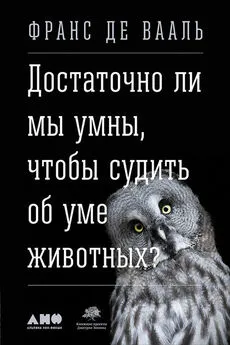
![Дебра Мерк - Девочка в гараже [Реальная история приемной мамы] [litres]](/books/1060538/debra-merk-devochka-v-garazhe-realnaya-istoriya-prie.webp)
